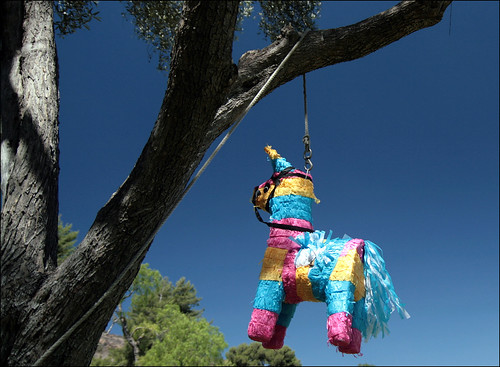Welcome to Word Buzz Wednesday, in which we round up our favorite buzzworthy words of the week. The latest: the end of the mobile search world as we know it; it’s raining nipperkins; and (don’t) Poptarko us out to the ballgame.
Also, be sure to check out the updated Poptarko entry for additional discussion on not-so-great portmanteaus and trademarked names.
Chilesaurus
“The curious form of Chilesaurus is an extreme example of mosaic convergent evolution, where different parts of an animal adapt to the environment along the same path taken by other creatures.”
Iam Sample, “‘Bizarre’ Jurassic dinosaur discovered in remarkable new find,” The Guardian, April 27, 2015
The Chilesaurus is a dinosaur of the Jurassic period considered “bizarre” because of its “curious mixture of features from different prehistoric animals,” says The Guardian.
The remains were first discovered in 2004 by a Chilean couple fossil hunting in the Andes. Their son, Diego, found a fossilized bone “that turned out to belong to the new species.”
The dinosaur’s full name is Chilesaurus diegosuarezi, named for where it was found and who found it, 7-year old Diego.
mobilegeddon
“Some people are calling it Mobilegeddon. That’s a bit of a stretch. But for the Google search engine—something that’s such big part of our daily lives—it’s likely the biggest change of the past three years.”
Cade Metz, “Google’s Search Update Will Remake the Web in Its Own Image,” WIRED, April 21, 2015
Mobilegeddon, a blend of mobile and armageddon, refers to Google’s recent updates to its search algorithms, which will make a site’s “mobile-friendliness” a determining factor in how prominently, if at all, it’ll appear in mobile search results. In other words, if a site isn’t mobile ready, there’s a chance people won’t be able to find it via their phones.
Check out more armageddon blends and these apocalypse words.
Nipyata
“And then there will be a chapter for the Nipyata, a novelty party item that stuffs cardboard donkey piñatas with tiny bottles of booze instead of candy. Blindfolded, dizzy drunks swinging a beating stick in a crowd of people…what could go wrong?”
Neil Casey, “Meet The Nipyata: A Piñata Filled With Bottles Of Booze,” Gothamist, April 26, 2015
The Nipyata combines a piñata and booze, or nip, figuratively and literally. A nip is a small amount of liquor, like the little (hopefully shatterproof) bottles of Jesus juice that rain down when the Nipyata is busted open.
The word nip is short for nipperkin, a “quantity of liquor of a half pint or less.” Nipperkin is of Dutch or Low German origin. Piñata in Spanish literally means jug or pot.
Poptarko
“The Bombers, a summer collegiate league baseball team, unveiled their new concession concoction for 2015 – dubbed the ‘Poptarko’.”
Bill Broderick, “New food item for Bombers is the Poptarko,” Battle Creek Enquirer, April 24, 2015
Poptarko, while an excellent name, is a horrific-sounding Pop-Tart-taco combination. Specifically, it’s a “double-decker taco” with a soft shell wrapped around a hard shell, and inside the shell, pulled pork and a brown sugar and cinnamon Pop-Tart. Of course a taco wouldn’t be complete without toppings, in this case, crumbled bacon, cheese, and more pieces of Pop-Tarts.
UPDATE: Editor Dawn McIlvain Stahl, aka PurplePenning, made a really good point: why is it Poptarko with a “k” and not Poptarco or Poptartco?
Professional name developer Nancy Friedman suggests that the “co” from taco might be misinterpreted as “company” and that the “k” might be reminiscent of pork. In addition, she says, “The big problem here could be unauthorized use of POP-TART, a registered TM of Kellogg.”
SnorriCam
“It’s a visual effect you can chalk up to the SnorriCam, a special device that mounts the camera directly on the actor’s body.”
Jacob T. Swinney, “A Video History of the SnorriCam, the Ultimate Cinematic Shorthand for Disorientation,” Slate, April 21, 2015
The SnorriCam creates a disorienting effect in film by making it seem as though everything except the actor is moving — in other words, the actor seems to hold perfectly still while the world whirls dizzyingly around him.
Icelandic filmmakers Einar Snorri and Eidur Snorri developed the technique using a special rig that attaches to the body “so one can walk or run with the camera locked on to oneself, keeping the face as an example steady in the frame and focus.”
Snorri and Snorri, by the way, aren’t related, but work together under the name Snorri Bros, to make things extra confusing.
[Photo via Flickr: “,” CC BY 2.0 by peasap]
